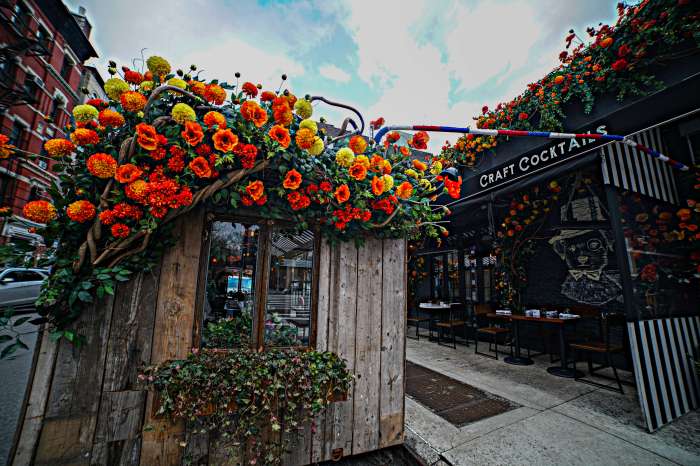-
 Vesta Trattoria
Vesta Trattoria
21-02 30th Ave.
The Italian restaurant offers dozens of wine selections, as well as exquisite Italian brunch and dinner menu items. vestavino.com
Himalayan Restaurant and Grill
25-94 Steinway St.
The South Asian eatery offers an eclectic menu and drink selection straight from the region. himalayanrestaurantandgrill.com
” data-id=”113462437″ data-link=”https://amnewyork.wpengine.com/wp-content/uploads/2019/10/13188_image.jpg” class=”wp-image-1.13462437″/>Photo Credit: Linda Rosier -
 Astoria Craft Bar and Kitchen
Astoria Craft Bar and Kitchen18-01 26th Rd.
The bar is a favorite for visitors with a dozen beers on tap, Trivia Tuesdays and several screens that play different live sports. astoriacraft.com
Don Coqui
28-18 31st St.
The lounge is Puerto Rican inspired and plays Latin dance music all night long. doncoqui.com
” data-id=”113462439″ data-link=”https://amnewyork.wpengine.com/wp-content/uploads/2019/10/13192_image.jpg” class=”wp-image-1.13462439″/>Photo Credit: Linda Rosier -
 Ophelia Theater
Ophelia Theater21-12 30th Rd.
The theater group puts on small, independent plays ranging from new musicals to classics. opheliatheatre.com
Hallets Point
The greenspace on the western edge of the neighborhood includes ballfields and a breathtaking view of the East River and Manhattan skyline.
” data-id=”113482927″ data-link=”https://amnewyork.wpengine.com/wp-content/uploads/2019/10/115_image.png” class=”wp-image-1.13482927″/>Photo Credit: Linda Rosier
Like most of Western Queens, Southern Astoria has become a mecca for young New Yorkers looking for a break from the crowded, expensive Manhattan scene, while still having that urban feel.
Its mixture of brick buildings and new glassy developments attracted a diverse set of residents to the area, from immigrants who have called the neighborhood home for decades to young professionals who are just starting their New York experience.
“We are a dynamic, diverse community and we are very accepting,” said Florence Koulouris, district manager for Queens Community Board 1, which covers the area.
But the newfound limelight is giving residents concern that the neighborhood could quickly become out of reach for middle-class New Yorkers.
The community is situated between the East River and the Brooklyn-Queens Expressway and by the Grand Central Parkway and 30th Drive. The majority of the buildings are residential houses and smaller apartment buildings, which are predominantly prewar walk-ups.
Those homes have been popular with immigrants for decades, according to Koulouris, and created mini melting pots within the blocks. Dilek Kaya, 22, moved from Turkey into the neighborhood two years ago with her husband and said she was immediately taken in by the diversity of the area.
“People are always talking to each other and [asking], ‘How are you doing? How is your family,’ ” she said. “They’re just constantly friendly.”
The ethnic variety extends to the area’s mom and pop stores, bars and restaurants, along Steinway Street, 21st Street and Astoria Boulevard. Every corner of the globe is represented in the neighborhood’s menu options such as the South Asian restaurant Roti Boti on 21st Street to the Latin American lounge Villa Restaurant on Steinway Street.
“It’s its own little city,” said Gabriela Machucha, 26, a kickboxing instructor who moved to the neighborhood three years ago. “I can get anything I want for lunch, like Greek food, or Indian food, without going far.”
The neighborhood is only a half an hour subway ride on the N or W train into midtown, which Koulouris points out has been advantageous for many residents who work in Manhattan. She added that the new Citi Bike stations that are scheduled to open in the area will help fill some of the transit gaps between the elevated train stations and side streets.
The area’s popularity has brought some change in recent years as high-end condos have been cropping up throughout the neighborhood, especially along the waterfront. And with those new homes came higher prices.
Median asking prices for homes in the area exceeded $1.1 million as of March 2017, compared to the $449,000 price a decade earlier, according to Street Easy. Queens’ median asking price, in comparison, was $599,000 in March. Southern Astoria median rents have gone from $1,995 in 2007 to $2,300 in March, and the number of available units has shot from 35 to 1,287 during that period, according to StreetEasy.
Some residents said they are concerned about possible gentrification.
“I give it 10 more years before everyone starts moving in here instead of Manhattan” said Ravhel Oyama, 31, who moved into Southern Astoria six years ago.
Monique Tatum, a real estate agent with Citi Habitats, said there are plenty of pockets for deal-minded home hunters, especially if they’re looking at an older apartment.
“The condos, a one-bedroom will rent between $2,150 to $2,400. For the same size apartment, in a prewar you can get something for $1,895,” she said.
Despite the surging prices, Koulouris said she’s confident the community would remain a haven for working-class New Yorkers who are looking for an open, friendly neighborhood.
“Anybody who wants to move to the area would be very happy,” she said.




























